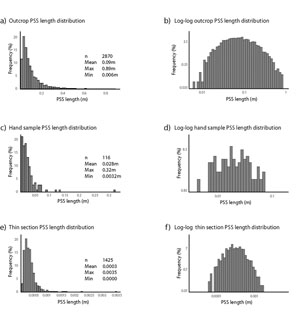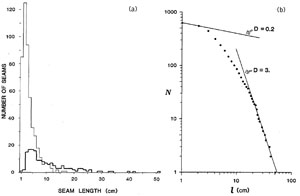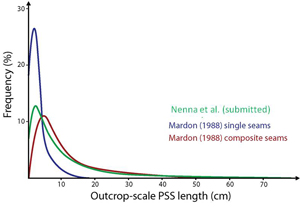| |||||||
|
|
|||||||
|
|
|||||||
| Pressure Solution Seam Length Distribution | |||||||
|
Figure 1 shows histograms of PSS length distributions at the outcrop (a-b), hand sample (c-d), and thin section (e-f) scale from a sandstone formation (Nenna et al., 2012). All magnitudes of lengths are less than 10 meters. Mardon (1988) has reported maximum lengths from PSSs in limestone exposed in the Appalachians, Pennsylvania, USA (Figure 2) even smaller than that of Nenna et al. However, Safarics and Davison (2005) reported stylolitic seams longer than 800 m in limestone exposed at Flambrough (UK) but no data set and criterion for identification of 'a single seam' was provided by these authors. The log-log plots for the data sets by Nenna et al. (Figures 1 (b), (d), (f)) suggest that the distributions are hyperbolic in form rather than log-normal, which is highly unusual. We note that the data sets in Figures 1 (a), (c), (e) would commonly be interpreted as log-normal in the literature on the fracture statistical distribution forms. For comparison, Figure 3 shows the length-frequency plots from Nenna et al. (submitted) and from Mardon (1988) for single and composite PSSs.
| |||||||
| Reference: |
|||||||
| Mardon, D., 1988 Nenna, F., Zhou, X., Aydin, A., 2012 Safaricz, M., Davison, I., 2005 |
|||||||
|
Readme | About Us | Acknowledgement | How to Cite | Terms of Use | Ⓒ Rock Fracture Knowledgebase |
|||||||


